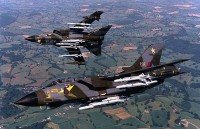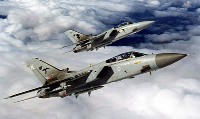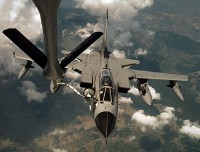Global Aircraft -- Tornado IDS/ADV
|
Aviation Center
US Attack
US Bombers
US Cargo
US Fighters
US Helicopters
US Patrol/Pursuit
US Reconnaissance
US Tankers
US Trainers
US UAV's
US X Planes
Orbiter Vehicles
WWI Aircraft
WWII Aircraft
Airbus
Antonov
Boeing
Dassault
Ilyushin
Kamov
MiG
Mil
Saab
Sukhoi
Tupolev
Yakovlev
Joint/Rest of World
Entertainment Center
Members Center
New Technologies
Contact Us
Extra Navigation
GAC Engine
Tornado IDS/ADV Specifications
Tornado IDS/ADV Achievements
Tornado IDS/ADV Features
IDS was the first production type developed from the MRCA (multi-role combat aircraft) program prototype. The IDS (interdictor/strike) variant is a true strike aircraft specialised at high speed low level flight with the variable wings and terrain following equipment.
The ADV (air defense variant) was developed for the air defense role. Primarily as an interceptor with look down shoot down capability to counter the threat of Soviet bombers. This variant features new engines for long high altitude flights and a longer airframe and nose to accommedate the Foxhunter air-to-air radar and Skyflash medium range air-to-air missiles. The Tornado has a computer controlled fly by wire system that ensures optimum performance wherever possible. The system has multiple redundancy built in to accommodate any number of potential failures. The system is comprised of several units that interact to minimise the risk of the aircraft leaving controlled flight. Flight Control System The Tornado has a triplex electronic flight control system commonly known as fly by wire although the Tornado maintains a mechanical backup system. The benefits of an electronic flight control system are many, some of the benefits are as follows; reliability, faster response, less physical engineering complexity, more sensitive control inputs. It should be noted that the failure of a combination of the systems will enable the mechanical direct input control system to become operational. This will usually transform the aircraft from one that can be thrown around with gay abandon to one that may be extremely sensitive to control input as the computers are not there to smooth and control the requests being fed to the operating surfaces. This type of system is usually only provided as a get you home option. The system is comprised of several units which are detailed below. AFDS - Autopilot and Flight Director System SPILS - Spin Prevention Incidence Limiting system The SPILS system is an integrated part of the Tornado flight control system. It's purpose in life is to ensure the Pilot cannot lose control of the aircraft during certain flight regimes. A term often heard when describing fly by wire systems is 'Carefree Handling'. This generally means that a Pilot can 'drive' the aircraft as they wish but this computer will stop any loss of control due to a request that the airframe cannot perform safely. In the Tornado's case a computer sits between the aircraft controls and the physical controlling surfaces such as the tailerons, rudder and spoilers. The computer receives signals from the pilot through the controls and decides whether or not to pass these to the control surfaces as requested by the Pilot. The computer also receives a vast amount of information from sensors mounted within the airframe and compares these against what the Pilot is asking for. It then instructs the control surfaces to deliver the best possible performance available for the manoeuvre requested without causing a departure. A departure is generally any loss of controlled flight. These systems are not foolproof, they will not for example stop the pilot flying the aircraft into the ground. JTIDS - Joint Tactical Information Distribution System JTIDS is in effect a cable free computer network. It allows the sharing of information between any validated user of the system. The system uses an encrypted and possible frequency hopping transmission to send and receive information in real time. A number of Tornado F.3 airframes have been modified to allow them to partake within the network. A valid user of the JTIDS system may be an AWACS aircraft, another F.3 or a ground station of some kind. It enables a higher state of situational awareness to be maintained and to ensure that other components of a combined attack force all have the same information.
Tornado IDS/ADV Background
During the 1960s, aeronautical designers looked to variable geometry designs to gain the manoeuvrability and efficient cruise of straight wings with the speed of swept-wing designs. Britain and France initiated the AFVG (Anglo French Variable Geometry) project in 1965, which ended with French withdrawal in 1967. In 1968, West Germany, the Netherlands, Belgium, Italy, and Canada formed a working group to examine replacements for the F-104 Starfighter, initially called the Multi Role Aircraft (MRA), and later called the Multi Role Combat Aircraft (MRCA). Britain joined the MRCA group in 1968, and a memorandum of agreement was drafted between Britain, West Germany, and Italy.
The programme was intended to produce a single-seat replacement for the F-104G, and a two-seat strike fighter for Britain and West Germany. Canada and Belgium pulled out in 1969. The four remaining partner nations - United Kingdom, Germany, Italy, and the Netherlands, formed Panavia Aircraft GmbH on 26 March 1969, though the Netherlands would pull out in 1970. The United Kingdom and West Germany each had a 42.5% stake, with the remaining 15% going to Italy. The scope of work for production was also agreed upon - the front fuselage and tail assembly in the United Kingdom, the centre fuselage in West Germany, and the wings in Italy. A separate multinational company, Turbo Union, was formed in June 1970 to develop and build the RB199 engines for the aircraft, with ownership similarly split 40% Rolls-Royce, 40% MTU, and 20% FIAT. At the conclusion of the project definition phase in May 1970, the concepts were reduced to two designs; a single seat Panavia 100 which West Germany initially preferred, and the twin seat Panavia 200 which the RAF preferred and which would become the Tornado. In September 1971 the three governments signed an Intention to Proceed (ITP) At this point, the aircraft was intended solely for the low-level strike mission. The RAF decided it needed an air defence fighter, and initiated the development of the Tornado ADV. The contract for the Batch 1 aircraft was signed on 29 July 1976. The first aircraft were delivered to the RAF and Luftwaffe on 5 June and 6 June 1979 respectively. The first Italian Tornado was delivered on 25 September 1981. On 29 January 1981 the Tri-national Tornado Training Establishment (TTTE) officially opened at RAF Cottesmore. Production ended in 1998; The last aircraft was completed by British Aerospace on 24 September, a RSAF (Royal Saudi Air Force) IDS. The Tornado was designed as a low-level supersonic ground attack bomber, capable of taking off and landing in short distances. This requires good high-speed and low-speed flying characteristics. In general, an aircraft which is designed to fly at high speeds usually has poor low-speed characteristics. In order to achieve the desired high-speed performance, an aircraft has a highly swept or delta wing platform. However, these wing designs are very inefficient at low speeds where unswept wing planforms are required. In order for an aircraft to be operated efficiently at both high and low speeds, variable wing sweep is a desirable feature; this was incorporated into the Tornado design. When the wings are swept back, the Tornado IDS increases its high-speed low-level capability by reducing drag. When sweeping, the wings partially slide into the fuselage, reducing the exposed wing area. This gives the aircraft a low gust response in turbulent low-level winds. This not only makes flight much more comfortable for the aircrew but makes the aircraft a more stable platform from which to aim and deliver unguided weapons at low level. The aircraft was designed to be land-based and operate from large airfields that were considered to be vulnerable to aerial attack. Therefore, during the development of the aircraft, short field landing capability was considered essential in order to enable the aircraft to operate from short strips on potentially damaged runways and taxiways. With the wings swept fully forwards the Tornado IDS generates greater lift because of the increased exposed wing area and the utility of full-span flaps and slats. This gives greater lift at lower speeds, reducing the minimum landing speed required and therefore giving shorter landing distances. Thrust reversers are also fitted to help in this respect, the Saab Viggen being the only other fighter aircraft to include this feature. The reversers contribute to the appearance of soot on the fin surface. The cockpit is of conventional design with a centre stick and left hand throttles. In general, when the pilot wants to fly at low speed, a cockpit selection lever is used to sweep the wings forward. This maximises lift. When flying faster the wings are swept further back. In flight the Tornado GR4 uses three sweep angles - 25, 45 and 67 degrees, with a corresponding speed range appropriate for each angle. Sweep may also change automatically to accommodate different store configurations, as these directly affect lift and drag characteristics. | ||||||||||||||||||||||||||||||||||||||||||||||





